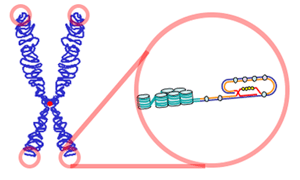
Why does the body age? If you’ve read much about aging, you’re probably aware that one of the main causes of aging is the shortening of telomeres– genetic buffers that lay on either end of our chromosomes.
But that’s only part of the story. Aging also has a lot to do with senescent cells– cells which, due to age, damage or mutation, have shut down and become non-functional.
Recently, a groundbreaking human study demonstrated that a combination of the leukemia drug dasatinib and the dietary supplement quercetin, taken for just three days, can significantly reduce the number of senescent cells in elderly people.
Now interest is growing in the use of senolytics– drugs which can kill senescent cells– as an anti-aging therapy. In fact, some biohackers are already taking dasatinib and quercetin themselves.
What Is Senescence? The Why and How Of Senescent Cells
Back in the 1960’s, it was discovered that cells stop dividing after about 50 divisions, becoming senescent. This (approximately) 50-division limit was dubbed the Hayflick Limit, after one of the scientists who discovered cellular senescence.
Senescence happens in part because telomeres get shorter with each division– once telomeres get very short or even non-existent, chromosomes become prone to degradation from oxidative stress or even self-inflicted damage as the body’s own DNA repair mechanisms can mistake the end of the chromosome for a double-strand break.

However, senescence does also occur in cells with plenty of telomere left. This can happen due to oxidative stress that gets past the telomeres, damage caused by toxins and radiation, or random mutation. In fact, cells will go senescent as a response to cancer-causing mutations, in order to protect the body from greater damage.
Until recently, scientists viewed these non-dividing cells as either inert, or as functioning just like normal cells except for the fact that they no longer divide. This is now understood to not be true.
Senescent cells have been implicated a variety of aging-related maladies. Mice show more age-related deterioration when senescent cells are implanted into them, and less when senescent cells are killed.
On the other hand, senescent cells can play a positive role in growth and healing, at least when they’re short-lived. Senescent cells form during wound healing, acting as a sort of temporary patch before dying off as the wound heals, which limits scar tissue formation.
And because senescence is a protective mechanism against cancer formation, preventing cells from becoming senescent when they need to actually guarantees that an organism will develop cancer. Think of the scene from every zombie movie ever where someone gets bitten, so he shoots himself before he can turn into a zombie– preventing senescence from ever happening is like preventing that guy from shooting himself.
So senescence is actually a good thing– but senescent cells should be short-lived. They’re normally destroyed by the body’s own natural killer cells, allowing the body to enjoy the positive effects of cellular senescence. However, as you get older, senescent cells build up, since they’re formed at a greater rate even while your body produces fewer natural killer cells.
And that begs the question– how to get rid of senescent cells, or prevent them from forming in the first place? How can we prevent our bodies from being overloaded with senescent cells as we get older?
One possibility would be to increase the body’s own natural killer cell activity. And then there’s the direct approach– senescent cell removal via the use of senolytic compounds.
Current Research Into Senolytics
A diverse variety of compounds, ranging from common dietary supplements to chemotherapy drugs, have been shown to have senolytic effects. That is, they can kill senescent cells, potentially reversing one aspect of the aging process.

On the other hand, a more powerful senolytics supplement may cause collateral damage– e.g the most powerful senolytics are often chemotherapy drugs, which make people sick. Cancer drugs can work both by killing senescent cells, and by turning cancer cells senescent– but at higher doses, many cancer drugs can actually promote senescence in healthy cells as well.
In short, you can definitely have too much of a good thing.
That said, senolytics consistently increase lifespan– and more importantly, healthy lifespan– in older mice and rats. It would seem that they’re beneficial in moderation, though it needs to be noted that parts of the aging process may work very differently in short-lived animals like mice compared to much longer-lived animals like humans.
Ideally, you’d like a) cancer cells to turn senescent, b) healthy cells to stay healthy and not turn senescent, and c) senescence cells to then die. It’s hard to promote one of these without compromising on one of the others.
Hard, but not impossible. Because different compounds work via different pathways, synergistic effects can be achieved by combining two or three that work via different mechanisms.
Natural Senolytics: Dasatinib And Quercetin, Circumen, Fisetin Senolytic, And More
Quite a few compounds have been shown to possess senolytic properties.
Quercetin, a flavonoid found in many fruits and vegetables but most especially in apples, inhibits the anti-apoptotic protein Bcl-xL. That’s why dasatinib and quercetin were used together– they have complementary mechanisms of action. Quercetin is, for now, the most-validated natural senolytics supplement.
Fisetin, another plant flavanol, seems to work by the same mechanism as quercetin. However, it has not yet been tested in humans in vivo, so the magnitude of fisetin senolytic benefits in live humans is still unknown.
Piperlongumine, an alkaloid found in peppers, has also shown senolytic effects, although research is still in the very early stages and focused on clarifying the mechanism of action. In any case, piperlongumine and quercetin are the main natural senolytics we know of right now, and by extension apples and long peppers are the best senolytic foods.
Circumin, a chemical found in turmeric, is commonly touted as an anti-aging supplement. However, to date curcumin anti-aging studies have found that it works via reducing inflammation or general oxidation. These are potential ways to slow aging, but they don’t suggest any circumin senolytic
Finally, there are some supplements which are not strictly senolytics, but may kill senescent cells indirectly, by increasing natural killer cell activity. Garlic extract, spirulina, ashwagandha (an anti-anxiety supplement we’ve already covered extensively), and ganoderma lucidum can all increase natural killer cell activity.
Senolytic Drugs
Dasatinib, the aforementioned leukemia drug, induces apoptosis (cell death) in senescent cells via inhibition of Src kinase. So far the evidence for dasatinib anti-aging benefits are compelling, but not conclusive– I’ll explain why in a minute.
The antibiotics azithromycin and roxithromycin also have senolytic effects. However, like all oral antibiotics they will damage the gut microbiome.
Navitoclax, another anti-cancer drug, has been demonstrated to induce apoptosis in human senescent cells– though only in vitro at this point.
If you want to use these drugs as senolytics, you’ll be using them off-label. You can find senolytic drugs for sale at various (mostly Indian) pharmacy sites– though they won’t be advertised as senolytics.
So should you start taking dasatinib and quercetin? Not quite yet. The dasatinib quercetin study is promising, to be sure, but it didn’t test everything you’d want to test, and it’s just one study. It found a reduction in senescent cell levels– but didn’t actually demonstrate improvements in health markers such as resting heart rate or glycemic control, or subjective quality of life. Most importantly, it did not (yet, at least) show that the subjects actually lived longer.
Forever Healthy, a non-profit organization that analyzes longevity research and provides summaries and recommendations for general population audiences, published a report recommending people wait for more research before taking dasatinib and quercetin as an anti-aging therapy. For now, we have to concur– this is worth keeping an eye on, but we’ll know a lot more in a few years.
Feature image by Michele Blackwell on Unsplash